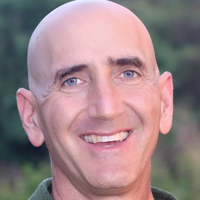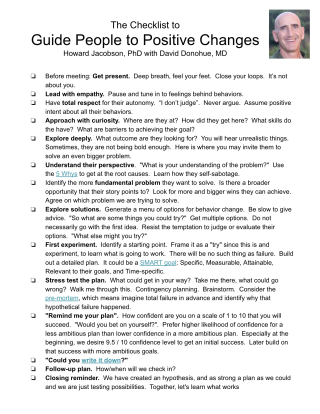The Checklist
If you need to help people make positive, healthy changes...
Why: Doctors and other clinicians are trained to input information and output orders. Effective coaching however relies more on empathetic connection than paternalistic transfer of instructions. If behavior change were as simple as deciding to do what is best, there would likely be no such thing as obesity or heart disease.
Most people who need coaching have already tried the easy solutions. They have already failed in any way they can imagine. They think of themselves as damaged and unworthy. They are primed for the next failure, waiting to kick themselves 1 more time and say "told you so, I can't do this".
Whether you are a doctor or a clinician or a concerned caregiver, you need to learn how to effectively coach the people in your care. Your mission: to help them believe in themselves, execute on a credible solution, and achieve long-term results.
Who: This checklist should be followed by anyone who wants to effectively coach clients, friends, or loved ones.
When: Run through this checklist before each coaching interaction with the person in your care. A session can be a clinical encounter, an online therapy session, or breakfast with your spouse.
- Before meeting: Get present. Deep breath, feel your feet. Close your loops. It’s not about you.
- Lead with empathy. Pause and tune in to feelings behind behaviors.
- Have total respect for their autonomy. “I don’t judge”. Never argue. Assume positive intent about all their behaviors.
- Approach with curiosity. Where are they at? How did they get here? What skills do the have? What are barriers to achieving their goal?
- Explore deeply. What outcome are they looking for? You will hear unrealistic things. Sometimes, they are not being bold enough. Here is where you may invite them to solve an even bigger problem.
- Understand their perspective. "What your understanding of the problem?" Use the 5 Whys to get at the root causes. Learn how they self-sabotage.
- Identify the more fundamental problem they want to solve. Is there a broader opportunity that their story points to? Look for more and bigger wins they can achieve. Agree on which problem we are trying to solve.
- Explore solutions. Generate a menu of options for behavior change. Be slow to give advice. "So what are some things you could try?" Get multiple options. Do not necessarily go with the first idea. Resist the temptation to judge or evaluate their options. "What else might you try?"
- First experiment. Identify a starting point. Frame it as a "try" since this is and experiment, to learn what is going to work. There will be no such thing as failure. Build out a detailed plan. It could be a SMART goal: Specific, Measurable, Attainable, Relevant to their goals, and Time-specific.
- Stress test the plan. What could get in your way? Take me there, what could go wrong? Walk me through this. Contingency planning. Brainstorm. Consider the pre-mortem, which means imagine total failure in advance and identify why that hypothetical failiure happened.
- "Remind me your plan". How confident are you on a scale of 1 to 10 that you will succeed. "Would you bet on yourself?". Prefer higher likelihood of confidence for a less ambitious plan than lower confidence in a more ambitious plan. Especially at the beginning, we desire 9.5 / 10 confidence level to get an initial success. Later build on that success with more ambitious goals.
- "Could you write it down?"
- Follow-up plan. How/when will we check in?
- Closing reminder. We have created an hypothesis, and as strong a plan as we could and we are just testing possibilities. Together, let's learn what works
Podcast
Listen to a podcast about this checklist
Contributors
This checklist was created by Howard Jacobson, PhD and David Donohue, MD during their podcast discussion January 3, 2020.

Howard Jacobson, PhD
Howard is the co-author of Sick to Fit, Use the Weight to Lose the Weight, Whole, Proteinaholic, and numerous other books.
Howard is host of the Plant Yourself Podcast, which has been in operation since 2015. He has interviewed hundreds of luminaries in all aspects of physical, spiritual, and environmental health.
Howard has coached thousands of clients toward better health. He also coaches coaches to be more effective.

David Donohue, MD MS FACP DipABLM
Dave is the creator of healthrules.org and helped build this checklist. He is a primary care internist, fellow of the American College of Physicians, and a diplomate of the American Board of Lifestyle Medicine.
Handout

References
Institute for Healthcare Improvemement. 5 Whys: Finding the Root Cause. http://www.ihi.org/resources/Pages/Tools/5-Whys-Finding-the-Root-Cause.aspx
White ND, Bautista V, Lenz T, Cosimano A. Using the SMART-EST Goals in Lifestyle Medicine Prescription. American Journal of Lifestyle Medicine. 2020;14(3):271-273. doi:10.1177/1559827620905775
Goodwin, Bryan. Research Matters / The Magic of Writing Stuff Down. April 2018 | Volume 75 | Number 7
Learning to Write, Writing to Learn Pages 78-79
Give Feedback
Is this checklist missing something? Do you have a success story from trying this checklist out? We would like to hear your feedback.


